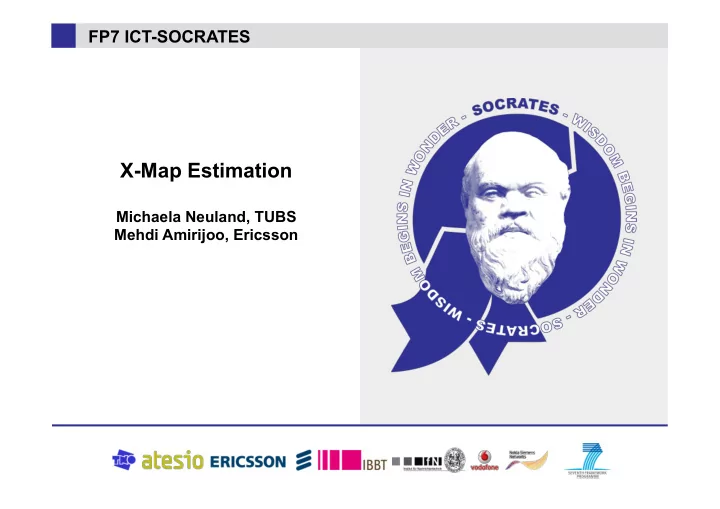

FP7 ICT-SOCRATES X-Map Estimation Michaela Neuland, TUBS Mehdi Amirijoo, Ericsson
Outline Introduction Study overview Current status Challenges WWW.FP7-SOCRATES.EU 2/15
Drive Tests Primary objectives of drive testing is to identify network performance using a reasonable sample of locations in the network Identify performance in terms of, e.g., – Coverage (e.g., pilot power) – Accessibility (e.g., random access) – Retainability (e.g., hand over) – Quality (e.g., throughput and speech quality) Sampling carried out manually by drive/walk tests Automation of drive tests has been proposed by NGMN due to limitations in drive/walk testing WWW.FP7-SOCRATES.EU 3/15
Drive Tests Only a limited part of network can be analysed Drive/walk test are costly Drive tests only capture a snapshot of the conditions in the field WWW.FP7-SOCRATES.EU 4/15
X-map Estimation Main principle: – Connect UE event/measurements with estimated position – Gather UE reports to build map relating geo reference data and metric of interest A map can indicate, e.g. – Path loss – Interference Used to detect, e.g. – Coverage holes – Service quality – Traffic density (used for e.g., site planning) WWW.FP7-SOCRATES.EU 5/15
Study Aim of study is not to develop positioning mechanisms – Quite siginificant work already done – Not within the scope of network management – Positioning is being studied for LTE We assume that UE positioning is in place Model accuracy of UE positioning techniques as a function of – RAT – radio environment – number of measured cells – etc. Model accuracy of UE measurements (RSRP, PL etc.) Use models to find map accuracy by means of simulations WWW.FP7-SOCRATES.EU 6/15
Study Output What is the map accuracy that can be obtained using today’s and tomorrow’s technology? – WCDMA positioning – GPS – LTE R8/R10 Understand map accuracy as a function of: – UE positioning accuracy – UE measurement accuracy – Number of measurements taken Are there other ways of improving accuracy? – Can UE measurements be combined with prediction data to obtain better accuracy? – Can we combine several sources from different RATs, GPS, prediction data? WWW.FP7-SOCRATES.EU 7/15
Study Output What is the positioning and measurement accuracy needed to obtain maps with sufficient accuracy? – Determine requirements on, e.g. UEs and positioning mechanisms – Determine feasibility of map generation Impact on interfaces, e.g., UE-eNodeB, X2 Impact on UEs Appropriate triggering of measurement reports – Identification of time + locations in the network WWW.FP7-SOCRATES.EU 8/15
Simulation Scenario Small realistic scenario of 1.5 km x 1.5 km in Braunschweig Static and mobile users based on a mobility model Network information available Realistic path loss information derived from a prediction model Source: Google Earth 5.0 Decorated user snapshots WWW.FP7-SOCRATES.EU 9/15
Position Error Modelling For LTE three different localisation methods are planned – GPS – Observed Time Difference of Arrival (OTDOA) – Enhanced cell ID positioning method Model for the position error based on the Cramér-Rao lower bound found in the literature This model is based on the – Geometry of eNodeBs / satellites and the UE – Number of measured signals – Standard deviation of the measurement error (for GPS: 33.3 ns) WWW.FP7-SOCRATES.EU 10/15
Position Error Modelling - GPS At the moment successive positions are uncorrelated Next step: applying some kind of filter to get a "flat" route WWW.FP7-SOCRATES.EU 11/15
Position Error Modelling - GPS distribution function position error in m mean error: 7.4 m standard deviation: 4.9 m WWW.FP7-SOCRATES.EU 12/15
Challenges How can we find realistic values for the achievable position accuracy and reliability? Can we improve the position error modelling? What are the error sources for localisation methods and how can we consider them? Can we benefit from combining different localisation methods? WWW.FP7-SOCRATES.EU 13/15
Recommend
More recommend